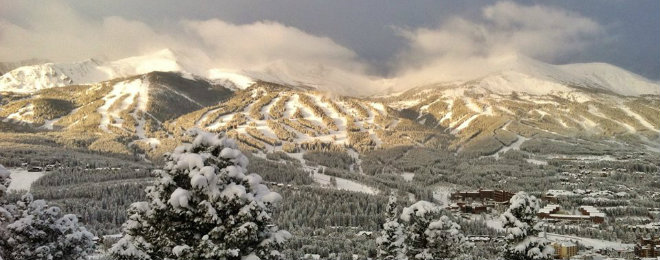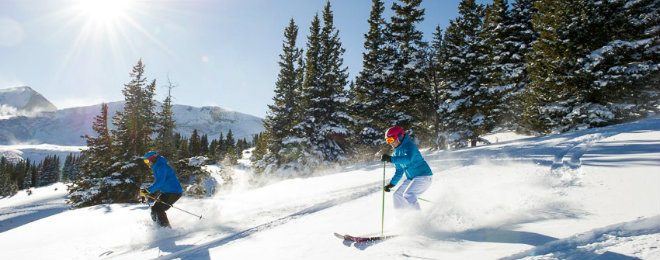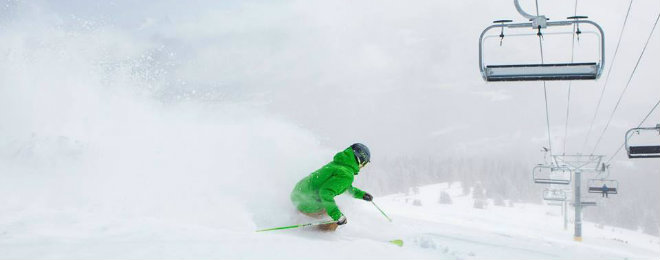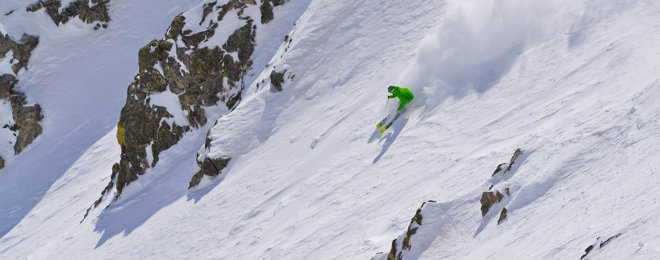Skiing in Breckenridge
Spread across four interconnected mountains, the skiing at Breckenridge is exceptional and exciting for every level of skier and boarder.

Breckenridge Ski Area Overview
With 2,908 acres (1177 ha) of skiing spread across five interconnected mountains (Peaks 6, 7, 8, 9, and 10), and averaging 300 inches of fluffy Colorado powder per year, the skiing at Breckenridge is exceptional and exciting for every level of skier and boarder.
Peak 7 made its debut over a decade ago, opening up 165 acres (66 ha) of intermediate terrain and seven new trails, and although it has been “tamed” there are still vast ungroomed upper sections of Peak 7 above the treeline to attract hardcore skiers. Peak 10 is by consensus the toughest, and Peak 9 the easiest of the other mountains, while Peak 8 is a bit of everything. The town and the ski area base are both at 9,600 feet (2,926 m) above sea level. The highest lift-serviced point is at 12,840 feet (3,914 m).
Peak 6 opened for the winter of 2014-2015 adding additional lift-serviced intermediate bowl terrain and some first rate hike-to runs for expert skiers.
Of the 155 trails, 24 are green beginner trails, 38 blue intermediate trails, and 74 black and double black diamond trails for advanced and experts. If you’re concerned about safety, you can be assured of a safe skiing and riding experience at this resort: Breckenridge Ski Patrol monitors each run every morning to check for safety hazards that may exist. All man-made objects are padded to specification and/or marked with bamboo, rope and flagging for visibility.
The ski area also includes four terrain parks and halfpipes, including the world class half pipe at Peak 8. To accommodate new trails and a new terrain park, the Breckenridge grooming fleet got three additional snowcats and new pipe-grooming implements. Artificial snowmaking includes 380 snowmaking guns covering 540 acres (227 ha)-24 percent of the mountain.
Beginner Skiing in Breckenridge
Breckenridge has some of the best beginner skiing in Colorado. Breckenridge offers hundreds of acres of exclusively beginner terrain served by high speed lifts and including several slow-skiing beginner trails supervised by ski patrols.

Breckenridge offers several trails designed for those who prefer to ski at a slower speed. Bonanza is the designated slow skiing trail on Peak 9, Springmeier on Peak 8. These runs are patrolled and monitored by Ski Patrol and Guest Service staff. Chair 5 offers access from Peak 8 base to a half dozen green runs. Kids will love the chair’s unique loading conveyor.
Breckenridge’s reputation as one of the best ski resorts in the United States for beginners was recently enhanced with the addition of the high-speed QuickSilver Super6, the country’s highest-capacity chairlift. This lift serves hundreds of acres of exclusively beginner terrain and its double-loading configuration allows beginners ample time to load comfortably. The wide-open, gentle beginner terrain aims to instill confidence and increase enjoyment for all novice skiers and riders.
A word of warning: remember that Breckenridge is high-even the bottom station stands at 9,600 feet (2,926 m) and the top soars to 12,998 feet (3,963 m), so beware of breathlessness and don’t attempt too much until you are acclimatized. Make sure you drink lots of water as well. Hydration is the best defense against altitude sickness. You may pant a bit at first, but you will live.
Intermediate Skiing in Breckenridge
Most skiers taking the BreckConnect gondola up from base pile out at the base of Peak 8, but intermediates would be better served by hopping off at the second midstation at Peak 7 base. There they will avoid the long early morning liftlines that can form when the gondola empties out a full day’s worth of skiers onto Rocky Mountain and Colorado SuperChairs.

But if you want to put miles under the skis, confident intermediates will relish the runs on Peak 7 accessed by the Independence Super Chair. Serviced by its own high speed express 6-passenger chair (Independence SuperChair), Breckenridge’s newly expanded terrain on the lower sections Peak 7 is an intermediate’s playground. Intermediate skiers will love the long runs and rolling terrain. Work your way across Monte Cristo, Angel’s Rest, Lincoln Meadows, Wirepatch, Pioneer and Claimjumper for fast, undulating cruisers. Advanced skiers looking to rip long carvers will also appreciate the bumps and rolls, particularly on the rollercoaster Claimjumper trail. Breckenridge’s Peaks 8 and 9 offer some great runs for intermediates, such as lengthy Four O’Clock and wide and bumpy Lehman.
Lower intermediates could start off with Breckenridge’s Peak 9, which offers open cruising all the way from the 11,460-foot (3,725 m) top, right down to the bottom. After a few runs up there you can move on to other slopes-there are plenty to choose from-and the new intermediate runs and glades on Peak 7. Two favorites for the permanent intermediate are both off Peaks 8 and 9. Peak 8 terrain varies from intermediate to advanced, but if you stick to the open, swoopy Four O’Clock-the longest run-you can have some great downhill skiing and not get too stressed. Also check out Spruce, and Frosty’s, and Dukes, all of which runs are groomed nightly and have a slightly steeper pitch.
From Peak 9, a favorite way down is via the Lehman run, or Cashier, which offers plenty of space and some deep moguls. Peak 9 also has Volunteer, American, and Peerless, while Peak 10 challenges intermediates with Doublejack, Centennial, Crystal and Cimarron, the former World Cup downhill race course, all of which are groomed and designated “blue/black.” A good day’s skiing in Breckenridge might include a warm-up on Peak 9 with Cashier, Bonanza, or Country Boy, or on Peak 8 with Springmeier or Four O’Clock, gradually easing into the more difficult “blue/black” runs.
Advanced & Expert Skiing in Breckenridge
Breckenridge’s expert skiing is first class. Often overlooked by experts, particularly in comparisons to its sister resort, Vail, Breckenridge offers some of the best expert ski terrain in Colorado.

The T-Bar, Chair 6, and the Imperial Express all service some serious expert terrain (see below for details). However, Breckenridge is probably better known for its below treeline expert terrain.
Take the Falcon SuperChair up Peak 10 to access a large swath of expert terrain. The Burn, Corsair and Spitfire, off the skier’s left, are steep, wooded runs that allow a skier to choose their level of challenge. While all three runs are moderately steep, the lines through the trees vary greatly and can range from challengingly tight to wider, but steep chutes. Hit up skier’s right off Peak 10 and you’ll drop into Mustang, Blackhawk and a handful of other double black diamond steeps. These runs cascade their way down to the base alternating between steep pitches and fairly flat runouts.
Chair E is an oft-overlooked expert’s playground. Because the terrain is not shown AT ALL on the front of the trail map (turn the map over…), many skiers simply don’t notice it. With names like Devil’s Crotch, Mineshaft, Hades and Inferno, you can imagine what the terrain is like. All the runs off Chair E will challenge even the most advanced skier. If you’re looking for a tight gladed run, try Windows, right off the top of the chairlift. The chutes are numbered on the traverse out. We like #4.
The south side of Peak 10 is a hidden paradise for bump-skiers with spectacular views of the valley. Try that out before moving onto the even steeper and tougher Lake Chutes-the best challenges for experts with pitches of up to 51 degrees and some areas accessible only from cornices or by going off-piste or into one of the bowls. Also try Horseshoe, Cucumber or Contest-all three are worthy double black diamond trails.
Experts should also ski the terrain off the midstation of the Peak 8 SuperConnect. Rising almost 1000 ft in only 3 minutes, riding the chair from the midstation allows you to log some serious vertical without long lines or slow chairs. Southern Cross and Mach 1 are all excellent pitches that bump up quickly. Tiger is a merciless double fall-line beast that lets you strut your stuff for the chairlift riders above.
Bowl Skiing in Breckenridge
Breckenridge’s above treeline skiing is very underrated. The resort offers many in-bound bowls for expert skiers, some lift accessible and others accessible by short hikes. Breckenridge’s Chair 6 offers access to the Imperial Express Quad terrain on the summit of Peak 8, but also serves a dozen advanced chutes and small bowls. After hitting the terrain off Chair 6, hop on the Imperial Express, North America’s highest chairlift, and ride it to the summit of Peak 8. For those who don’t like to hike, there is plenty of bowlskiing available without a hike. The more adventuresome should try taking the short 10-15 minute hike above the Imperial Express to access bowl skiing at the summit. Standing on the summit you’ll be at an elevation of 12,998 feet (3,963 m) with Breckenridge’s total vertical of 3,398 feet (1,036 m) below you. Continue hiking farther out to the skier’s right to get to the Lake Chutes (the steepest terrain at Breckenridge) or Snow White Bowl.
If wide-open bowl skiing with plenty of snow is what you desire, then you should head to Horseshoe Bowl, which is accessed by Chair 6 and the T-bar lifts. The ride up the T-bar is certainly worth the antiquated lift. Horseshoe Bowl, Cucumber Bowl and Contest Bowl are all outstanding. They are steep and the powder tends to blow into these bowls more so than some of the others, making for some great soft turns. As for the best powder, that’s definitely to be found on the bowls of Peak 8, but this means you must be willing to hike above the tree line.
In 2014, the resort opened new terrain on Peak 6. This new bowl terrain in Serenity Bowl and Beyond bowl is mainly hike-to terrain above the top of the Kensho Superchair. The runs are amongst the steepest on in the ski area. The one lift-serviced expert trail, Wonderland, is a short, fun pitch that many experts have yet to find because Peak 6 is mainly intermediate terrain.
If you want to go beyond the ski area boundary and access the backcountry, use the designated gates only. Areas beyond the ski area boundary are not patrolled or maintained. Avalanche slopes, unmarked obstacles and other natural hazards exist. Rescue in the backcountry, if available, is the responsibility of the Summit County Sheriff, and your wallet. It will be costly and may take time. What’s more, the backcountry avalanche hazard may be extreme. Also there’s no sponsored guiding available for off-piste adventures.
Boarding & Freestyle in Breckenridge
Breckenridge was the first major Colorado resort to encourage boarders and hosted the world’s first freestyle snowboarding event in 1985. Today Breckenridge boasts five first-class Terrain Parks and four halfpipes for snowboarding and freestyle skiers, and hosts various World Cup Events. The Peak 8 Freeway Terrain Park is one of the best facilities in North America.
The Peak 8 Freeway Terrain Park is renowned for its award-winning SuperPipe, a 300-foot (90 m) half-pipe, and it was voted one of the four best in North America by American Snowboarder magazine. The resort’s adjacent snowboard park was rated the second-best facility in the country in the same readers’ poll. The park’s impressive series of large tabletops and spines, with slopes of up to 15 degrees, makes it a popular site for the advanced and expert boarder. Peak 9 is home to the Country Boy and Gold King Terrain Parks which are less daunting facilities. Hits and features are more subdued for the budding freerider and skier. Trygve’s and El Dorado are designed specifically for beginner freestyle riders. They have smaller features and halfpipes.
Overall, Breckenridge’s network of lifts between mountains allows for easy access for boarders, but you may want to stay away from Lower Sawmill, as its extremely gentle slope is not conducive to snowboard gliding.
Mountain Restaurants in Breckenridge
Breckenridge’s mountain restaurants are mostly food-court style with outside seating – when it’s not too cold – on heated decks with great views, but watch out for over-crowding in the most popular restaurants at peak periods when finding a seat indoors can be difficult.
The Ten Mile Station is Breckenridge’s latest-it’s at the top of the QuickSilver Lift on Peak 9 and is a mining-themed restaurant and Coffee Depot with a spacious heated deck.
Peak 8 is the most popular spot for lunch due to its central location at the middle of Breckenridge’s four interconnected mountains. The Vista Haus Restaurant on Peak 8 (at the top of the Colorado and Peak 8 SuperConnect chairs) is a recently renovated facility with fantastic views, serving breakfast and lunch with an open seating area. However, along with its Peak 8 base sister restaurant, the Bergenhof, the Vista Haus is probably the most crowded of Breckenridge’s lunch spots and finding a seat can be difficult. Try having lunch at an off hour (before 1130 or after 130) if you’re set on eating at Peak 8.
At the base of Peak 8, you’ll find the Bergenhof, a popular and unassuming lunch spot. Seating inside can be tight on busy days, but if it’s not too cold, outside seating is plentiful. The dozens of pink and green plastic Adirondack chairs offer a great spot to sit back and relax while enjoying the great views. The Tiki Bar on the deck serves up great burgers and other grilled specialties at a remarkably reasonable price.
The Maggie, a locals’ favorite at the base of Peak 9, serves breakfast and coffee in the morning and a variety of American favorites for lunch. Also on Peak 9, at the top of the Beaver Run Chair, is the Peak 9 Restaurant.
Sevens is a new pizza restaurant at the base of Peak 7 scheduled to open in the Spring of 2009.










